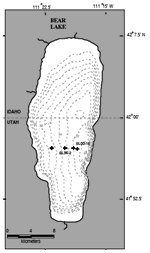
The overall goal of our research on Bear Lake is to create records of past climate
change for the region, including changes in precipitation (rain and snow)
patterns during the last 10,000 years and longer. As part of the project,
we are attempting to determine how the size of Bear Lake has varied in
the past in order to assess the possibility of future flooding and drought.
We also seek to understand human influences on sediment deposition, chemistry,
and life in the lake.
Evidence of past conditions comes from sediments deposited in the lake, so reconstructions
of past conditions require accurate dating of the sediments. The study
includes the upper Bear River watershed as well as Bear Lake. The Bear
River is the largest river in the Great Basin and the source of the majority
of water flowing into the Great Salt Lake. In this region, wet periods
may produce flooding along the course of the Bear River and around Great
Salt Lake, while dry periods, or droughts, may affect water availability
for ecosystems, as well as for agricultural, industrial, and residential
use.
Diatoms are one of the most sensitive indicators of environments in many lakes.
In addition to species compositions and abundances (Moser and Kimball,
2005), total diatom productivity commonly varies considerably with changes
in limnological conditions. Biogenic silica preserved in sediments is
an index of total diatom productivity and, thus, is an indirect proxy
for paleolimnology (for example, Colman and others, 1995; Johnson and
others, 2001). In this paper, we present the results of biogenic silica
analyses of two cores taken in Bear Lake, Utah, and discuss preliminary
paleolimnologic conclusions based on these data.
Version 1.0
|
| Posted September 2005 |
|
Part or all of this report is presented in Portable Document Format. The latest
version of Adobe Acrobat Reader or similar software is required
to view it. If you wish to download the latest version of Acrobat
Reader free of charge, click here.
|
|

